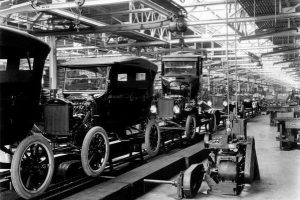7.0 Introduction
Learning Objectives
At the end of this chapter, learners will be able to:
- Describe technology and examples
- Explain short-run and long-run
- Describe marginal and average products of labour
- Elaborate marginal and average costs
- Recognize average costs and marginal costs graphs
- Identify firms long-run decisions
The Assembly Line- A Cost Revolution

In 1908, the automobile industry changed forever. The first automobiles date back to the 15th century when Leonardo da Vinci was creating designs and models for transport vehicles. Karl Benz, a German inventor, developed the first gas-powered automobile in 1885, and the first American car manufacturer opened in 1893. However, until 1908, the automobile was a luxury enjoyed only by the rich. It was not a technological innovation that changed the industry, but rather a revolution on costs.
Henry Ford, an American car manufacturer, developed a method that steadily reduced the cost of the automobile: the assembly line. Rather than having workers involved with each component of the manufacturing of a vehicle, workers specialized in certain areas. This example illustrates the marginal product of labour, a concept we will explore in this chapter. We will see that the MPL will rise as you add more workers, as each new worker helps make the assembly line more efficient than before.
Attribution
“Introduction to Cost and Industry Structure” in Principles of Microeconomics by Dr. Emma Hutchinson, University of Victoria is licensed under a Creative Commons Attribution 4.0 International License, except where otherwise noted.

